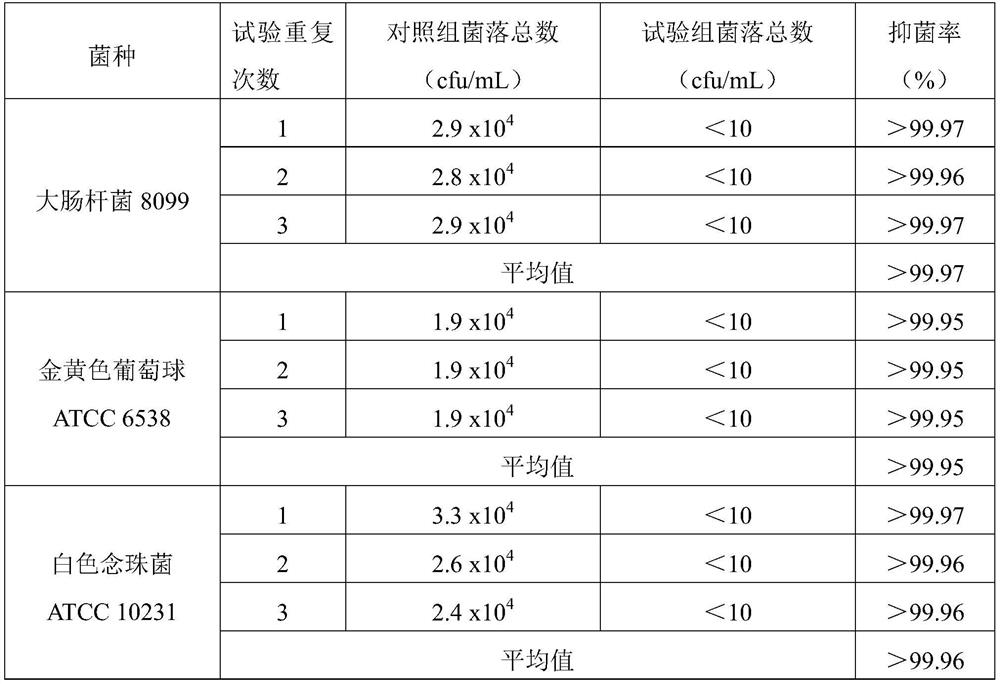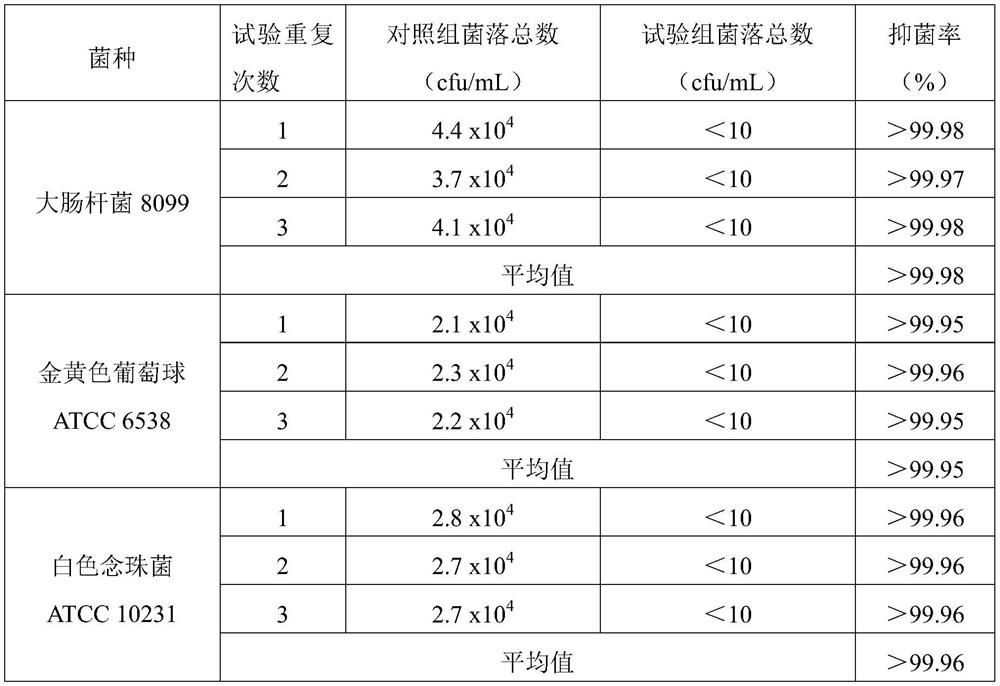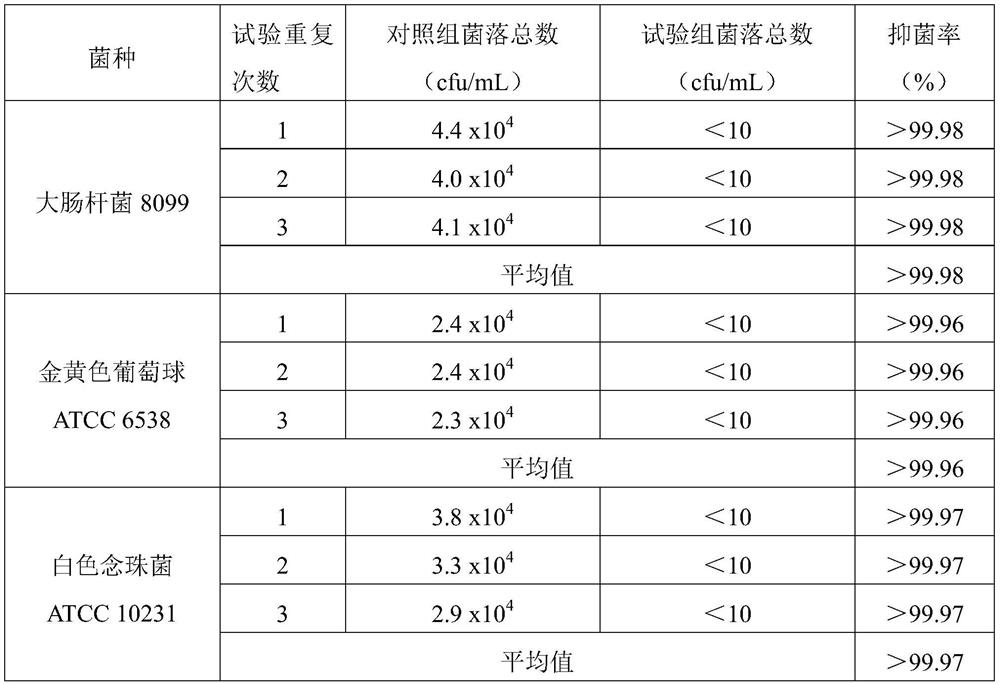A long-acting antibacterial and virus-killing sanitation protective product spray and its application
A protective product and virus-killing technology, which is applied in the direction of biocide, application, disinfectant, etc., can solve the problems of long-lasting effect, little virus effect, strong irritation, etc., achieve long-lasting antibacterial effect, improve retention characteristics, and skin-free stimulating effect
- Summary
- Abstract
- Description
- Claims
- Application Information
AI Technical Summary
Problems solved by technology
Method used
Image
Examples
Embodiment 1
[0045] Example 1 Protective Products Purification Liquid Fungi Effect
[0046] Follow the following formulations to configure antibacterial killing virus protective supplies purification solution: polyethylene glycide hydrochloride: 0.5%; nano-silver gel: 0.05% in the silver concentration, quality concentration; 1% oligonthium chloride 1% quaternary ammonium epitaxyl bromide; mutual leaf white oil: 0.0005%; 4% dimethyl dichlorosilane, 4% phenylchlorosilane, 2% of trimethyl chloride; propylene glycol: 6% ; Water: margin.
[0047] The bacteriostatic performance test for protective supplies was carried out with reference to GB15979-2002, and the purification liquid of protective article was used to purify the liquid, 5 min, 10 min, 20min, and the test was repeated 3 times. The strains used are E. coli (ATCC 8099), Golden Staphylococcus aureus (ATCC 6538), and the antibacterial properties of the protective supplies purified solutions are characterized by its aprotic ratio (ATCC 6538)....
Embodiment 2
[0058] Example 2 Protective Products Purification Liquid to kill viral effects
[0059]Follow the following formulations to configure antibacterial killing virus protective supplies purification solution: polyethylene chloride hydrochloride: 0.02%; nano-silver gel: 0.002% by silver concentration, mass concentration; 0.5% quaternary ammonium chloride , Ethodoalkyl bromide 0.5%; mutual leaf white layer oil: 0.0005%; dimethyl dichlorosilane 2%, phenylchlorosilane 2%, trimethyl chloride 1%; propylene glycol: 3% ; Water: margin.
[0060] According to the identification test of the physical removal method of the "Disinfection Technical Specification" 2002 Edition residual disinfectant, the chemical infectivirus inactivation test was performed on the control of the protective supplies and three consecutive tests. The virus used is an antiviral properties of the anti-viral properties of the protective article purifying liquid (ie, the disinfectant in Table 2), and the viral titer is chara...
Embodiment 3
[0070] With the formulation of Example 1, the protective article purification liquid was configured, and the outer surface of the used KN90 mask was uniformly sprayed. The amount of use of each mask was 2 to 4 ml, and after the surface of the mask was wet, it was dried at 90 ° C for 30 minutes. I.e.
[0071] The PaLAS MFP3000 modular filtration performance tester is used to analyze the interception characteristics and resistance of masks (85 l / min, sodium chloride less than 0.3 um, temperature 25 ° C, relative humidity 75%), using YG461E non-woven gas permeability Test for mask thief (20cm 2 , Pressure 200Pa). The test results are shown in Table 4.
[0072] Table 4 Revoupling and resistance test of postmography after purification liquid for protective supplies
[0073]
[0074] After the treatment of protective supplies, the protective properties of the mask are not substantially affected, and the intervalness of its interval declines, but in line with national standards; its ...
PUM
 Login to View More
Login to View More Abstract
Description
Claims
Application Information
 Login to View More
Login to View More - R&D Engineer
- R&D Manager
- IP Professional
- Industry Leading Data Capabilities
- Powerful AI technology
- Patent DNA Extraction
Browse by: Latest US Patents, China's latest patents, Technical Efficacy Thesaurus, Application Domain, Technology Topic, Popular Technical Reports.
© 2024 PatSnap. All rights reserved.Legal|Privacy policy|Modern Slavery Act Transparency Statement|Sitemap|About US| Contact US: help@patsnap.com










